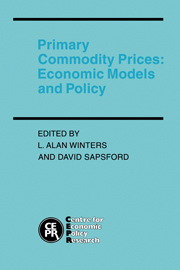Book contents
- Frontmatter
- Contents
- List of figures
- List of tables
- Preface
- List of conference participants
- 1 Primary commodity prices: an introduction to the major policy and modelling challenges
- I ECONOMETRIC ANALYSES
- II SECTORAL STUDIES: FOODS, MATERIALS AND ENERGY
- 5 Modelling the interactive effects of alternative sets of policies on agricultural prices
- 6 Price determination in the market for aluminium
- 7 Long-run factors in oil price formation
- III STABILIZATION SCHEMES
- Index
7 - Long-run factors in oil price formation
from II - SECTORAL STUDIES: FOODS, MATERIALS AND ENERGY
Published online by Cambridge University Press: 05 March 2012
- Frontmatter
- Contents
- List of figures
- List of tables
- Preface
- List of conference participants
- 1 Primary commodity prices: an introduction to the major policy and modelling challenges
- I ECONOMETRIC ANALYSES
- II SECTORAL STUDIES: FOODS, MATERIALS AND ENERGY
- 5 Modelling the interactive effects of alternative sets of policies on agricultural prices
- 6 Price determination in the market for aluminium
- 7 Long-run factors in oil price formation
- III STABILIZATION SCHEMES
- Index
Summary
The purpose of this study is to discuss some of the factors that are crucial in the determination of long-run international petroleum prices, to explore what impact these factors might have, and to clarify whether the price formation process in petroleum differs significantly from that in other primary commodity markets. The time horizon of the study is the next 2–3 decades. Sections 2, 3, 4 and 5 explore, in turn, the roles of (a) exhaustibility; (b) monopolistic forces; (c) inter-fuel substitution; and (d) future technological shocks, represented here by the possibility of a moratorium on nuclear power, or of severe restrictions on carbon dioxide emissions. However, in order to provide a broader context, and a historical perspective on the subject, Section 1 reviews the prices of petroleum and other primary commodities since the beginning of the present century.
The historical evidence of prices: oil and other primary commodities
Figures 7.1–7.4 depict indices of real prices between 1900 and 1986 for oil, metals and minerals, non-food agricultural commodities and food commodities. An ocular inspection of the oil price developments reveals a gentle downward slope beginning after the first world war, and ending in the early 1970s, when, in the view of a majority of economists, the OPEC cartel drove up prices to historically unprecedented levels. The slow downward slope is interrupted by a much steeper temporary decline in the latter half of the 1940s, caused by the opening up of the rich Middle East oil resources on a large scale.
- Type
- Chapter
- Information
- Primary Commodity PricesEconomic Models and Policy, pp. 157 - 180Publisher: Cambridge University PressPrint publication year: 1990



